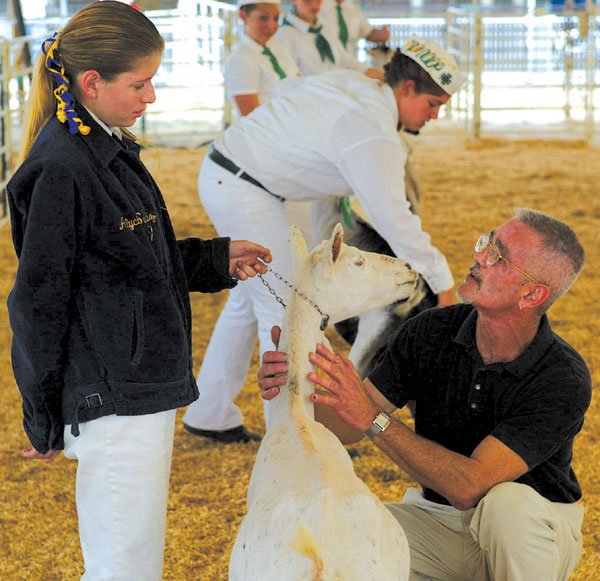Santa Clara County’s victory in litigation with the city of San
Jose over a theater project at the county fairgrounds could signal
the beginning of the end for the county fair, and the beginning of
smaller 4-H fair in South County.
Santa Clara County’s victory in litigation with the city of San Jose over a theater project at the county fairgrounds could signal the beginning of the end for the county fair, and the beginning of smaller 4-H fair in South County.
The county’s contract with Fairgrounds Management Company expires next year, and the fair’s dismal performance in recent years, combined with the county’s success in litigation, means that 2005 might be the last time there’s a fair in San Jose, or anywhere else for that matter.
“I don’t want that to happen, but it might be,” Supervisor Don Gage said Friday. “We might have to wait a couple of years until I can find some land in South County for a permanent facility.”
On Thursday, a San Mateo County Superior Court judge affirmed that the county has sole authority of the fairgrounds and removed a major obstacle for construction of a new concert theater that fairgrounds management hopes to use as a cash cow to overhaul the complex.
Under a plan adopted in 1998, improvements to the grounds will include a 50,000-square foot exhibition hall, a sports and recreation facility and an underground parking structure, all without tax dollars.
They do not include plans for a midway – games and rides – and agricultural events which are heavily reliant on public funding.
“When you have people dressed up to go to the theater or a concert you don’t want to have animals or the circus of a midway,” Gage said.
And in its current incarnation, the fair is a money loser. Three years ago, it was shortened from 10 days to three, but still has not managed a profit.
Arthur Troyer, the executive director of FMC, said that poor attendance has muddied the relationship between the fairgrounds and the county.
“It’s unclear whether the county wants to renew the contract,” he said Friday. “The fairgrounds needs serious assistance to fix buildings. The fair itself is not performing well. The financial picture is not a pretty one. We need to reorganize our financing.”
What is clear to everyone in county government is that the revitalization called for in the 1998 plan is the quickest route to financial prosperity. That plan, though, was conceived in a booming economy, and is now tied up in litigation. So far, the county has prevailed.
San Jose has 10 days to amend the complaint that was dismissed Thursday, but Santa Clara County Counsel Ann Ravel said Friday that “the judge has written such an iron-clad legal decision that it will be extremely difficult for her to rethink her order. The city will be hard-pressed to show a cause of action.”
Then there’s the lawsuit filed by the San Jose Downtown Association that claims the theater project is illegal under California contract law and violates the California Environmental Quality Act. A hearing on that case is scheduled for Jan. 31.
The county can not issue bonds for the theater project until the litigation is complete, but Gage is already at work on his plan to preserve a smaller version of the fair at a South County location.
At the moment, he’s shopping for a location and is hopeful that someone will donate the land for a small fairgrounds in exchange for a tax write-off. His first choice was Bear Ranch in Gilroy, but it is operated by the County Parks and Recreation Department, which has major development plans for the 4,500-acre ranch, anchored by an 18-hole golf course.
“I’m looking for someone to donate the 100 acres we’ll need for a fair and parking and then we’ll see what the costs are for facilities,” Gage said. “If we’re going to make improvements, they might as well be permanent.”
Albert Escobar of the Adams 4-H in Gilroy said Friday he’s sure members from around the county would welcome the move, especially if it will save farm events from extinction.
“It would be a shame if it had to go away for a few years because there wasn’t enough financing,” he said. “I can’t speak for members in North County, but I think they’d rather have it moved down here than not have it at all.”
Moving the ag events will leave the San Jose grounds free to host revenue-generating events with big-name music and stage acts.
“That may have some merit, an events center vs. a South County fair,” Troyer said. “Preserving the tradition of 4-H and Future Farmers of America is the raison d’ etre of the fair. But getting from here to there is not an easy thing to do,” he said. “You can’t just go down to South County and find an open field, pitch a few tents and have at it. We’re not going to do it without a long look at the logistics and financing.”
Most fair facilities are temporary, but any site would need water, electricity and sewage services. It would also need the support of the community.
“Having it in a more ag-integrated area will probably build renewed interest, but you’ve got to be careful. A lot of areas talked about will impact residential neighbors and traffic.”
Gage is confident South County will welcome the fair.
“I think I can get people to donate because it’s a good thing for kids,” he said. “It would be off of 101 or a major thoroughfare, and really, it’s not that much traffic. We’ll minimize whatever the downside would be.”












